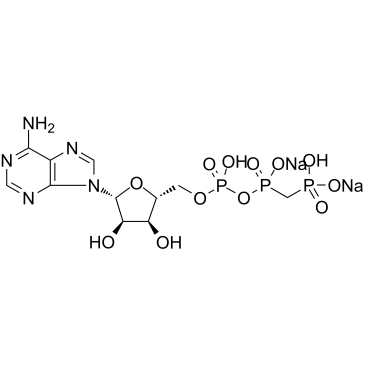ADENYLYLMETHYLENEDIPHOSPHONATE SODIUM SALT

ADENYLYLMETHYLENEDIPHOSPHONATE SODIUM SALT structure
|
Common Name | ADENYLYLMETHYLENEDIPHOSPHONATE SODIUM SALT | ||
|---|---|---|---|---|
| CAS Number | 7414-56-4 | Molecular Weight | 549.17 | |
| Density | N/A | Boiling Point | N/A | |
| Molecular Formula | C11H16N5Na2O12P3 | Melting Point | N/A | |
| MSDS | Chinese USA | Flash Point | N/A | |
| Symbol |

GHS06 |
Signal Word | Danger | |
Use of ADENYLYLMETHYLENEDIPHOSPHONATE SODIUM SALTAMP-PCP disodium is an ATP analogue and can bind to Hsp90 N-terminal domain with a Kd value of 3.8 μM. AMP-PCP disodium binding favors the formation of the active homodimer of Hsp90[1]. |
| Name | AMP-PCP disodium |
|---|
| Description | AMP-PCP disodium is an ATP analogue and can bind to Hsp90 N-terminal domain with a Kd value of 3.8 μM. AMP-PCP disodium binding favors the formation of the active homodimer of Hsp90[1]. |
|---|---|
| Related Catalog | |
| Target |
HSP90:3.8 μM (Kd) |
| In Vitro | AMP-PCP binding favors the formation of the active homodimer of Hsp90 by enhancing the slow-motion featured conformational exchanges of those residues (A117-A141) within the lid segment (A111-G135) and around region. In total, 170 non-proline residues are identified for the triple-labeled Hsp90 bound with AMP-PCP[1]. |
| References |
| Molecular Formula | C11H16N5Na2O12P3 |
|---|---|
| Molecular Weight | 549.17 |
| Storage condition | -20°C |
| Symbol |

GHS06 |
|---|---|
| Signal Word | Danger |
| Hazard Statements | H301-H311-H315-H319-H331-H335 |
| Precautionary Statements | P261-P280-P301 + P310-P305 + P351 + P338-P311 |
| Personal Protective Equipment | Eyeshields;Faceshields;Gloves;type P2 (EN 143) respirator cartridges |
| Hazard Codes | T |
| Risk Phrases | 23/24/25-36/37/38 |
| Safety Phrases | 22-26-36-45 |
| RIDADR | NONH for all modes of transport |
|
Two distinct origins for Leydig cell progenitors in the fetal testis.
Dev. Biol. 352 , 14-26, (2011) During the differentiation of the mammalian embryonic testis, two compartments are defined: the testis cords and the interstitium. The testis cords give rise to the adult seminiferous tubules, whereas... |
|
|
Mitochondrial GLUT10 facilitates dehydroascorbic acid import and protects cells against oxidative stress: mechanistic insight into arterial tortuosity syndrome.
Hum. Mol. Genet. 19 , 3721-33, (2010) Mutations in glucose transporter 10 (GLUT10) alter angiogenesis and cause arterial tortuosity syndrome (ATS); however, the mechanisms by which these mutations cause disease remain unclear. It has been... |
|
|
Subcellular localization of rice histone deacetylases in organelles.
FEBS Lett. 583 , 2249-54, (2009) Histone deacetylases (HDACs) are known to function in the nucleus. Here, we report on the organellar localization of three rice HDACs, OsSIR2b, OsHDAC6, and OsHDAC10. The 35S:OsSIR2b-GFP and 35S:OsHDA... |